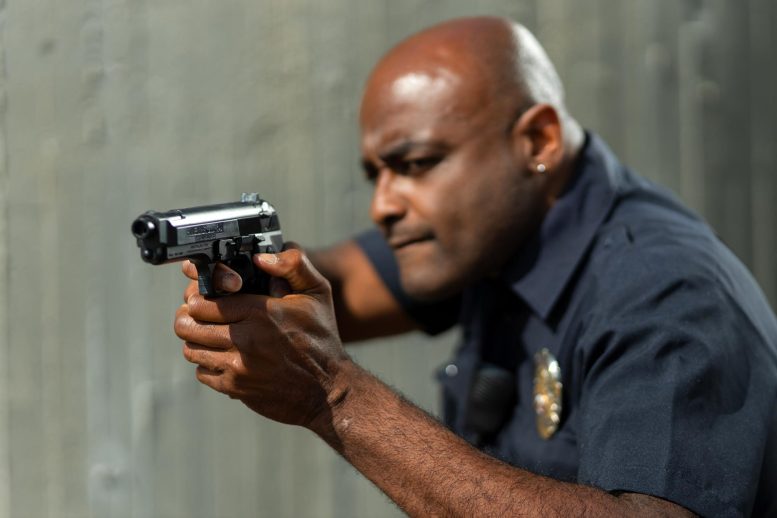
Over 55% of deaths resulting from police violence in the USA between 1980 and 2018 were either misclassified or unreported in official vital statistics reports.
- Researchers compared data from the US National Vital Statistics System (NVSS) to three non-governmental, open-source databases on fatal police violence and found that NVSS under-reported deaths from police violence by 55.5% between 1980-2018.
- Over the 40-year study period (1980-2019), Black Americans were estimated to be 3.5 times more likely to die from police violence than white Americans.
- Open-source databases should be better utilized to improve reporting on fatal police violence and support policy changes to address systemic racism and reduce police violence.
More than 55% of deaths from police violence in the USA from 1980-2018 were misclassified or unreported in official vital statistics reports according to a new study in The Lancet. The highest rate of deaths from police violence occurred for Black Americans, who were estimated to be 3.5 times more likely to experience fatal police violence than white Americans.
Researchers estimate that the US National Vital Statistics System (NVSS), the government system that collates all death certificates in the USA, failed to accurately classify and report more than 17,000 deaths as being caused by police violence during the 40-year study period.
“Recent high-profile police killings of Black people have drawn worldwide attention to this urgent public health crisis, but the magnitude of this problem can’t be fully understood without reliable data. Inaccurately reporting or misclassifying these deaths further obscures the larger issue of systemic racism that is embedded in many US institutions, including law enforcement. Currently, the same government responsible for this violence is also responsible for reporting on it. Open-sourced data is a more reliable and comprehensive resource to help inform policies that can prevent police violence and save lives,” says co-lead author Fablina Sharara of the Institute for Health Metrics and Evaluation (IHME), University of Washington School of Medicine, USA.
To examine the extent of under-reporting, researchers compared NVSS data to three non-governmental, open-source databases on police violence: Fatal Encounters, Mapping Police Violence, and The Counted. These databases collate information from news reports and public record requests. When compared, the researchers’ new estimates highlight the extent to which deaths from police violence are under-reported in the NVSS and the disproportionate effect of police violence on Black, Hispanic, and Indigenous people in the USA.
Across all races and states in the USA, researchers estimate that NVSS data failed to report 17,100 deaths from police violence out of 30,800 total deaths from 1980-2018 (the most recent years of available NVSS data), accounting for 55.5% of all deaths from police violence during this period. Using a predictive model, researchers also estimated the total number of deaths from police violence in the USA, for all races/ethnicities and all states for 2019, estimating an additional 1,190 deaths, bringing the total number of deaths from police violence from 1980-2019 to 32,000.
Black Americans experienced fatal police violence at a rate 3.5 times higher than white Americans, according to this analysis, with nearly 60% of these deaths misclassified in the NVSS (5,670 unreported deaths from police violence out of 9,540 estimated deaths). From the 1980s to the 2010s, rates of police violence increased by 38% for all races (with 0.25 deaths from police violence per 100,000 person-years in the 1980s as compared to 0.34 deaths from police violence per 100,000 person-years in the 2010s).
Compared to the deaths recorded in the new analysis, NVSS also missed 56% (8,540 deaths out of 15,200) of deaths of non-Hispanic white people, 33% (281 deaths out of 861) of non-Hispanic people of other races, and 50% (2,580 deaths out of 5,170) of Hispanic people of any race.
Deaths due to police violence were significantly higher for men of any race or ethnicity than women, with 30,600 deaths in men and 1,420 deaths in women from 1980 to 2019.
Previous studies covering shorter time periods have found similar rates of racial disparities, as well as significant under-reporting of police killings in official statistics. This new study is one of the longest study periods to date to address this topic.
The authors call for increased use of open-source data-collection initiatives to allow researchers and policymakers to document and highlight disparities in police violence by race, ethnicity, and gender, allowing for targeted, meaningful changes to policing and public safety that will prevent loss of life.
Additionally, the researchers point out that because many medical examiners or coroners are embedded within police departments, there can be substantial conflicts of interest that could disincentivize certifiers from indicating police violence as a cause of death. Managing these conflicts of interest in addition to improved training and clearer instructions for physicians and medical examiners on how to document police violence in text fields on death certificates could improve reporting and reduce omissions and implicit biases that cause misclassifications.
“Our recommendation to utilize open-source data collection is only a first step. As a community we need to do more. Efforts to prevent police violence and address systemic racism in the USA, including body cameras that record interactions of police with civilians along with de-escalation training and implicit bias training for police officers, for example, have largely been ineffective. As our data show, fatal police violence rates and the large racial disparities in police killings have either remained the same or increased over the years. Policymakers should look to other countries, such Norway and the UK, where police forces have been de-militarized and use evidence-based strategies to find effective solutions that prioritize public safety and community-based interventions to reduce fatal police violence,” says co-lead author Eve Wool of the Institute for Health Metrics and Evaluation (IHME), University of Washington School of Medicine, USA.
The authors acknowledge some limitations in the study. This paper does not calculate or address non-fatal injuries attributed to police violence, which is critical to understanding the full burden of police violence in the USA and should be examined in future studies. The data also do not include police officers killed by civilians, police violence in USA territories, or residents who may have been harmed by military police in the USA or abroad. Because the researchers relied on death certificates, which only allow for a binary designation of sex, they were unable to identify non-cisgender people, potentially masking the disproportionately high rates of violence against trans people, particularly Black trans people. The authors note that the intersectionality of gender, race/ethnicity, sexual orientation, and other identities and the relationship to fatal police violence should be studied in the future.
A Lancet Editorial adds, “The study is a potential turning point for improving national estimates of fatalities from police violence by incorporating non-governmental open-source data to correct NVSS data…Better data is one aspect of a public health approach; introducing harm-reduction policies is another. Policing in the USA follows models of hostile, racialized interactions between civilians and armed agents of the state. Marginalized groups are more likely to be criminalized through the war on drugs or homelessness. Reducing hostile or violent interactions between police and civilians, particularly those who are most vulnerable overall, is a forceful case for investment in other areas of community-based health and support systems, including housing, food access, substance use treatment, and emergency medical services. Strategies to lower fatalities from police violence must include demilitarisation of police forces, but with the broader call to demilitarize society by, for example, restricting access to firearms…Police forces too must take greater responsibility for police-involved injuries and deaths. Such changes are long overdue.”
Reference: “Fatal police violence by race and state in the USA, 1980–2019: a network meta-regression” by GBD 2019 Police Violence US Subnational Collaborators, 30 September 2021, The Lancet.
DOI: 10.1016/S0140-6736(21)01609-3
This study was funded by the Bill & Melinda Gates Foundation, the National Institute of Minority Health and Health Disparities, and the National Heart, Lung, and Blood Institute. A full list of authors and institutions is available in the paper.









Quite interesting that this media outlet chose to use the stock photo of a “black” police officer, to suggest that the problem is not with caucasian police officers shooting “African Americans.”
Greetings, “They” do not care what you think! Otherwise,”they” would not have printed such pap under science of any kind. I just dropped them. Mac
over 57% of all murders in america are committed by blacks
https://mycousinthecarp.blogspot.com/2021/09/black-murder-data-matters-1257-or-101.html
“the larger issue of systemic racism that is embedded in many US institutions, including law enforcement.” Conclusions based on someone’s opinion, only. It’s the cudgel of “disproportion” which has become a political tool; used for shaming.
These broad brush indictments of America and by implication all White Americans are incredibly divisive and unhelpful.
This research is fatally flawed and is leaning dangerously close to political propaganda. An examination of police use of fatal force that disparages outcomes by US law enforcement in comparison to European countries like Norway or the UK is only possible by completely ignoring the context and environment related to violent and, particularly, firearm-related crime in the United States. While it is true that a black male is three and a half times more likely than average to be a victim of police use of deadly force, that statistic only tells a portion of the story. That same male is SIX TIMES more likely to have been the victim or perpetrator of a felony homicide-the vast majority of which involve a firearm.
Let’s just ignore the fact that a police officer is 18.5 times more likely to be shot by a black man than a white man, let’s also ignore that for every black man shot by police there are hundreds of black men shot by other black men. This article is agenda driven propaganda, nothing more.
I go to scitechdaily to read about science not political propaganda. I am changing my reading habits if scitech continues with is type of misinformation. Quite a reach to put this under the category of Science News. I can read this pap anywhere. Science News? I don’t think so. True representation of facts? Definitely not! Just plain crap pure and simple. Sorry I don’t have an opinion on the matter! Forewarned is Forearmed. Mac
Just unsubscribed. Mac
Have we forgotten those institutions are representative of the States historical Confederate past. I live in Novato, California, a former pro-Confederate State. Our local mountain i.e. Mt. Burdell was formerly called N(word)-mountain (Google it) and it’s in our historical museum. The officer in the photo would be called here a House-N(word). This is what I grew up with. My two guardian angels growing up were black so don’t hate on me for reminding us of our past before the 13 colonies and the founding of our nation. Biasedness should have ended after the Civil War, emancipation proclamation, the slave act and the civil rights act.
In 2020:
1) blacks (12% of population) commit 40% of all cop killings.
2) A police officer is 18 times, and up to 30 times, more likely to be killed by a black male than an unarmed black male is likely to be killed by a police officer.
Source:
Federal Bureau of Justice
Manhattan Institute scholar, Heather MacDonald
FBI Uniform Crime Report
Washington Post
The Director of the National Institute of Justice found that black officers in the New York Police Department were 3.3 times more likely to use their guns at shooting scenes than White officers.
4) In late 2020, the Bureau of Justice Statistics released a report that found no statistically significant difference by race between criminal activity and arrest. In other words, you get arrested in America if you are reported to have committed a crime, no matter your race.
5) In 2019, NPR cited a peer-reviewed finding that White officers were no more likely to kill unarmed black suspects than black officers were. Of course, cases where unarmed black suspects are killed by black officers are not of interest. These incidents are never given wall-to-wall media coverage. That’s reserved for the white officer.
6) In a typical year, roughly 20 unarmed black suspects are killed by police. The black adult population in 2019 was 31,140,331. The 20 unarmed black suspects (out of 31 million black adults) killed by police is light-years away of being an epidemic.
7) 12% of all Whites and Hispanics who die of homicide are killed by police officers. 4% of all blacks, homicide victims, are killed by police officers. So it would make more sense to call it White and Hispanic Lives Matter.